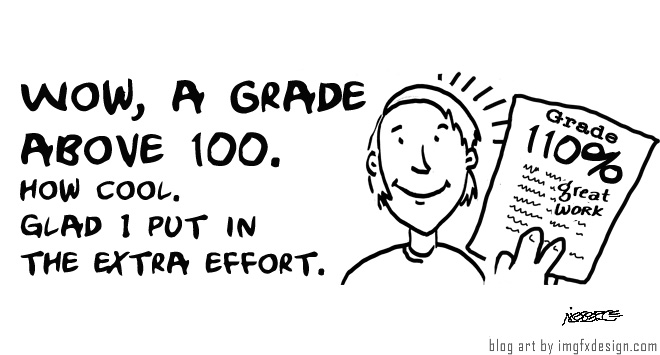 Effectively motivating undergraduate students is paramount to the success of our educational system. In my recent years of teaching I have applied to students techniques I have used for motivating individuals in the workplace during my 20 years of management consulting and hotel operation. Techniques that proved very effective when implemented in the undergraduate business school classroom included:
Effectively motivating undergraduate students is paramount to the success of our educational system. In my recent years of teaching I have applied to students techniques I have used for motivating individuals in the workplace during my 20 years of management consulting and hotel operation. Techniques that proved very effective when implemented in the undergraduate business school classroom included:
- Communicate high expectations directly and apply the sandwich principle
- Award high achievers with assignment grades near and above 100
- Provide high levels of structure and frequent assignments for students who typically don’t care
Classroom Management Motivation Techniques: Communicate High Expectations
Professors need to be very candid with students about their expectations, and show examples of excellent and poor submissions with student names concealed. By directly showing them what is excellent work and what is shoddy work, the majority of students instantly become motivated to produce far superior work. Professors can raise the bar by effectively applying candidness and the sandwich principle.
A good example of applying these techniques occurred while teaching Marketing Management. On the second weekly mini-case assignment I was extremely disappointed by the lack of effort, creativity, strategy and resourcefulness put forth by the vast majority of 200 students. A portion of the assignment was to construct a SWOT Analysis (Strengths, Weaknesses, Opportunities and Threats) for Atlanta’s Georgia World Congress Center (GWCC). Students were to evaluate Atlanta against the other top five convention destination cities including New York, Las Vegas, Orlando and Chicago. As a starting point I gave them relevant information on hotel capacities, historical annual convention show figures and four articles from the Atlanta Journal Constitution and the Atlanta Business Chronicle, rich with strategic issues. Students were also told to continue to research these two newspapers for additional articles. In class we developed a very sophisticated example of a SWOT Analysis example for Starbuck’s Coffee, see premium attachment.
Student submissions reflected inadequate levels of resourcefulness as they obviously failed to read the four articles provided as well research additional articles on their own. Creativity and applied strategy were also grossly missing. Many students put a lot of things down to create the illusion of an extensive job; however, when we read the responses many were meaningless to the point of being silly. One student had developed some quality bullet points but then diluted them with meaningless points that collectively made the submission of poor quality. Some of these senseless bullet points are shown below. The entire submission can be seen at GWCC SWOT Analysis.
Strengths
- Two full service FedEx-Kinkos within the GWCC. (Very, very minor issue.)
- First state-owned and operated convention center in the US. (History not relevant to strategy)
Opportunities
- Heavily recruit [this university’s] students to apply their technology-based thoughts and ideas to revamp the GWCC. (Inexperienced students are going to make immediate impact?)
- Ranked fourth best city for jobs in 2008-extremely useful statistic for recruiting. (No relevance ?)
Weaknesses
- Consumes 50 million kilowatts of energy per year – enough to power more than 3,000 homes.(No relevance?)
During class I projected samples of poor quality submissions including the one reference above and also provided a recommended answer key that can be seen at GWCC SWOT Analysis Answer Key. I was very direct with the students by communicating the following:
- I would not tolerate their not being resourceful, and I would hold them responsible for reasonable levels of research.
- Their responses were being read, not just skimmed or looked at for length by those grading. “Filler” and senseless inclusions would severely reduce overall grade. Quality not quantity was required.
- Strategy and creativity needed to be exerted and just throwing down poorly developed content would result in low grades.
Now it was time to apply the sandwich principle in motivating people. After creating this higher expectation, I challenged the students to “step it up.” Next I communicated with great confidence that I knew they were capable of achieving this. (Note that this school has an average freshman SAT score of typically around 1,250.
After this motivational lecture, the vast majority of assignment submissions drastically improved for the duration of the semester. To recognize this I gave out nearly 200 miniature Nestle 100 Grand bars with custom stickers reading “GRAND JOB…WAY TO STEP IT UP!”
Motivation and Learning Through Sharing Student’s Assignments: Inferior as well as Superior
Showing inferior as well as excellent student submissions is very effective; however; students many times are initially adverse to this and you need to have adequate faculty oversight support. Students often learn as much from “poor examples” as well as “superior” submissions. The names of students whose assignments you project in front of the class are not revealed. It is necessary to reinforce that students should not take this personally, it is to benefit everyone. I received feedback from a student that supports this very effective teaching technique:
“You’re very funny, love the magic, love the enthusiasm in general. LIKE going over homework (student submissions) with entire class – keeps us accountable and helps us to learn from each other’s successes/mistakes.”
Motivation Elevated with Assignment Grades Near and Above 100
Many professors avoid giving students grades near or at 100 as this reflects a “perfect” submission. This approach is very demotivating. The only time I got involved in my son’s college education with faculty was when he was penalized for attending an optional speaker (with an associated assignment) because he had traveled out of state unexpectedly to his grandmother’s funeral. I composed a grade appeal for him. The professor’s response to the department head explained that my son’s grade didn’t matter. To influence his grade my son would have needed a 100 on the assignment. Getting a 100 on an assignment “was impossible” as this professor never gave out scores of 100.
Assignments should be developed so that students are capable of succeeding. Students feel a great deal of satisfaction from receiving a high grade and this motivates them to exert high levels of effort on future assignments. Rewarding students with grades near or at 100 is highly motivating.
Taken to even a different level, I strongly believe in rewarding students with grades above 100 if their submission reflects elevated levels of effort in conjunction with displaying problem solving that is creative, strategic and resourceful. You can see how motivating it is for students to get grades above 100 from reading a portion of an email I received from a Marketing Management student:
“One of the primary motivation techniques in Heller’s course was his grading system. On the weekly assignments, it was not uncommon to receive 5-15 points of extra credit if one went above and beyond the scope of the assignment. The first time I received a 110, I was so motivated to do even better on the next assignment. Each Thursday, I looked forward to getting my assignments back to see what grade I received and read the positive comments.”
Motivating Students Who Don’t Care (Initially)
The keys to motivating students who don’t care include frequent graded assignments, unannounced quizzes and individual versus group assignments. I challenge myself to motivate not only the high achieving students, but also the unmotivated students who would ordinarily not learn much. To motivate those who don’t care requires high levels of structure and techniques that truly push them.
- Increase assignment frequency from a few times a semester to weekly graded assignments to force students to constantly complete assignments each week except leading up to testing periods. Unfortunately, assigning a few long-term projects results in procrastination by the majority of students with drastically less time allocated than professors expect. See posting entitled, “The Benefits of Weekly Assignments versus Major Long-Term Projects.”
- Use unannounced quizzes to assure that students are coming prepared to class having read the assigned materials. See posting entitled, “Application versus Content in Conjunction with Unannounced Quizzes.”
- Eliminate the vast majority of group work which often dilutes quality time effort of the weaker students in group. The exception to this is if the business school has elevated admission requirements. See posting entitled, “The Unfortunate Motivation Behind Assigning Group Work.”
- Use the crib sheet testing approach which requires the students to expend a sufficient amount of quality time consolidating their set of multiple page notes allowed. See posting entitled, “Application Oriented Tests and Crib Sheets are a Winning Partnership.”
College Student Motivation Propelled Forward
Creating effective motivational techniques is best viewed as if you are the student’s coach rather than professor. You need to push your students to the next level with high expectations. Setting the expectation bar high can create a terrific learning experience.
A coach or professor always has a certain percentage of students who are not necessarily that motivated. These students can be pushed through providing effective structure by incorporating frequent assignments, unannounced quizzes, individual work and Crib Sheets.
